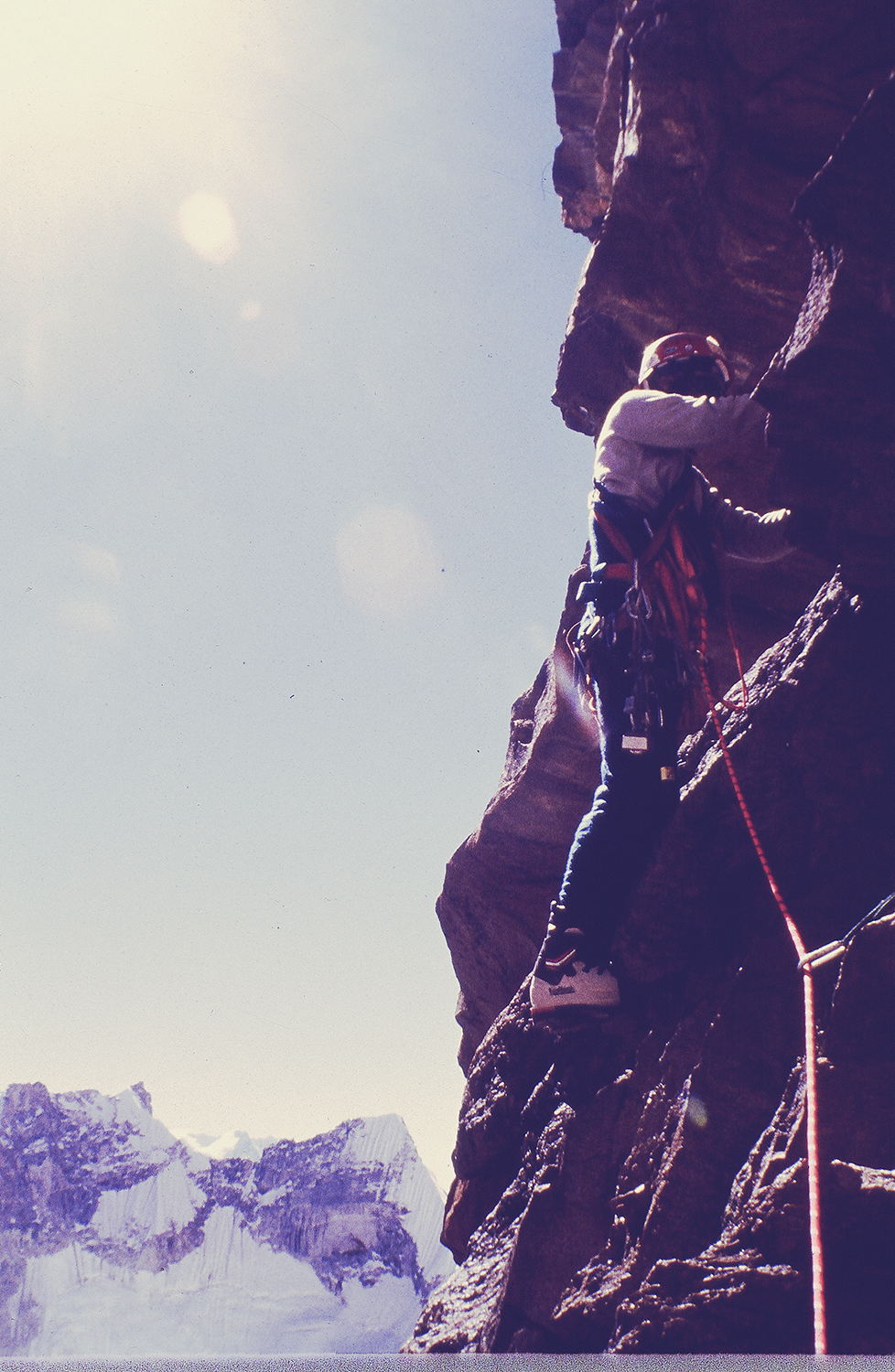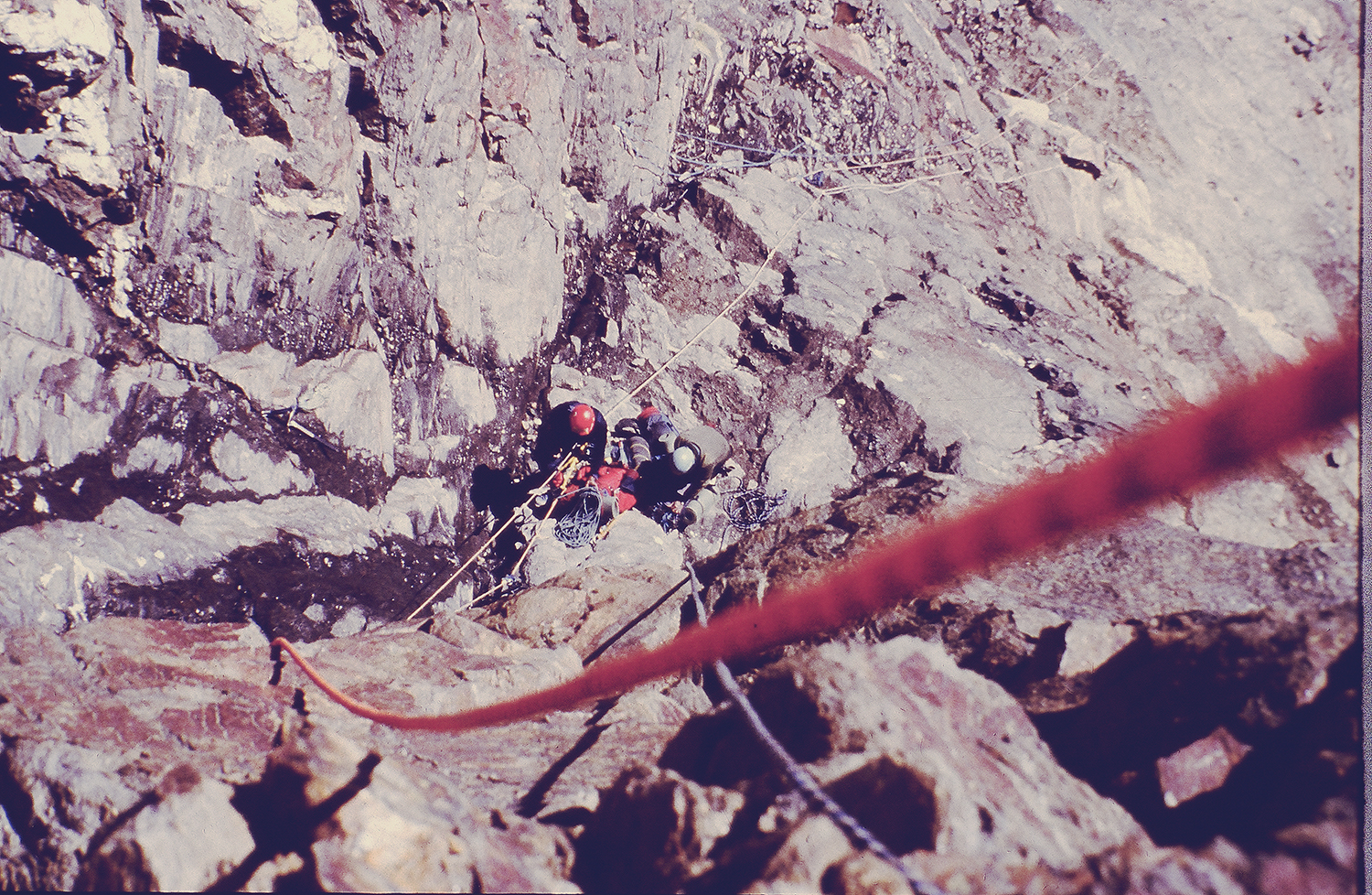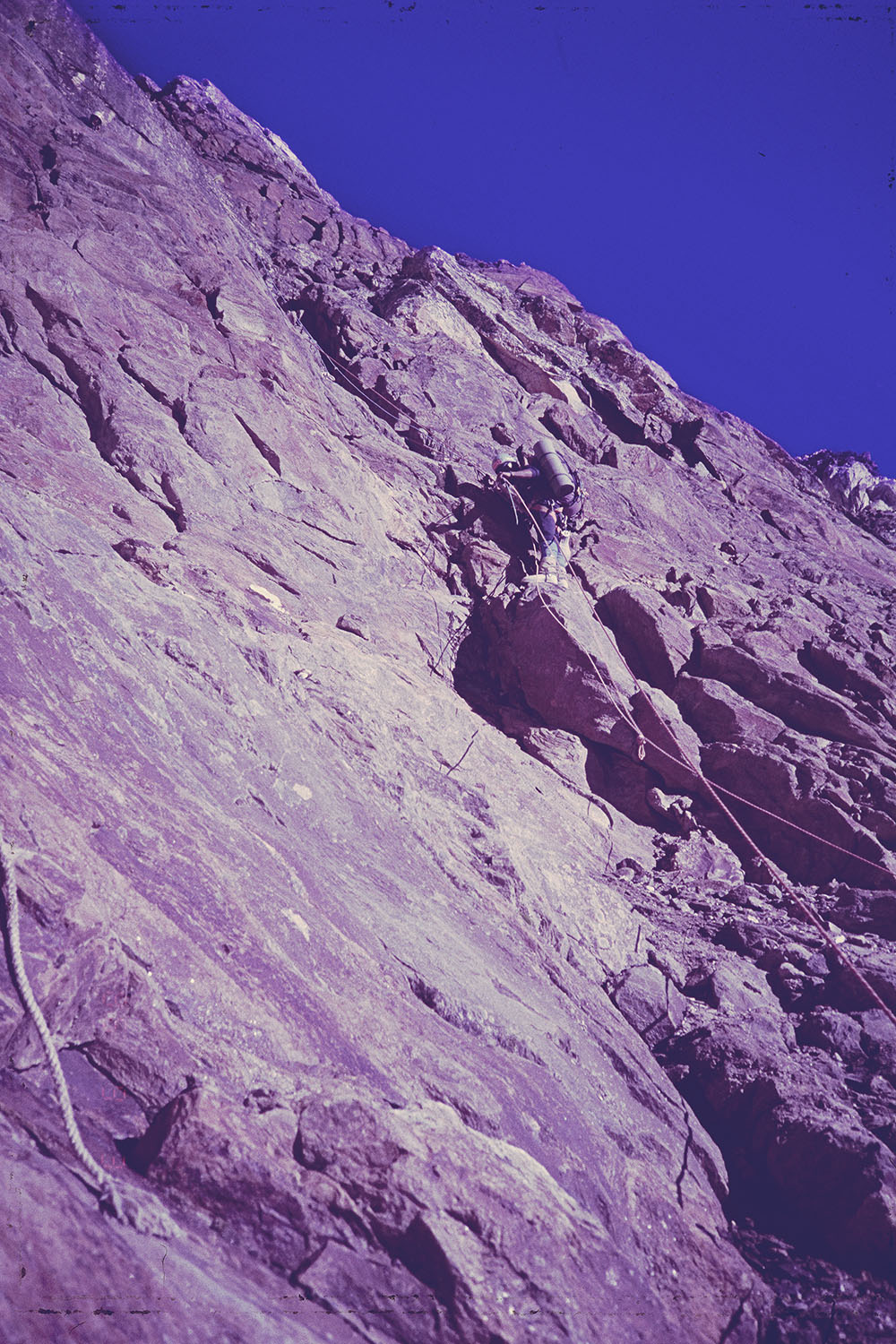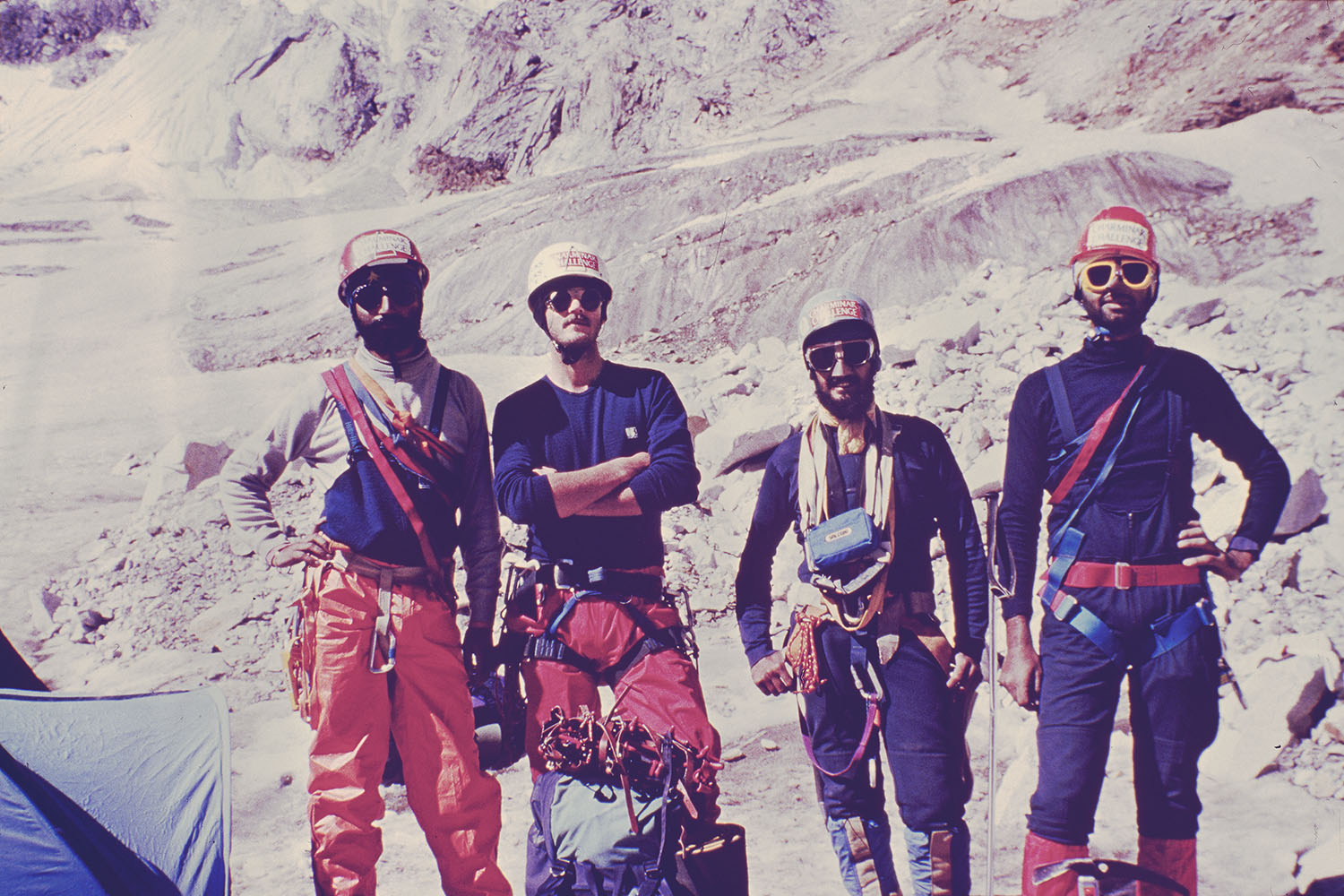First Indian ascent of Meru North -- a personal account

In 1986, mountaineer Mandip Singh Soin and a small group of friends made the first Indian ascent of Meru North, alpine style — fulfilling one climber's determination to defeat the crux that had been his undoing before.
The camera panned in slow motion sweeping across the 2,460-foot rock face to the glacier below. As I clung on at the crux, hammering a piton for protection, I felt the shiver again. Not from the 5°Celsius temperature while climbing at over 18,000 ft, but because I had just then sensed the enormity of this exercise.
My wife Anita, pregnant with our daughter Himali, had fretted frantically when I first told her I was planning to embark on an expedition with two Indians and a Swedish friend to climb Mount Meru. I soothed her with euphemisms: It’s a cakewalk, I said, a mere stroll through the Himalaya. Later, however, as we watched the telecast footage, Anita gasped. Everything came to scale: suddenly, the contortion on the screen seemed not too hard after all, whilst by contrast, in my own bedroom that evening, I hung on for dear life, fearful of the imprecations of my outraged wife.
And suddenly, it seemed unfortunate that Åke Nilsson, our Swedish friend, had filmed the climb so beautifully and that Charu Sharma had told its story with eloquence, for the film captured the experience perhaps too accurately and poignantly for my wife. The footage was aired on prime time television soon after the movie Gandhi. I tried, weakly, to remind Anita of the philosophies of ahimsa as she muttered beneath her breath.
The ‘clinging on at the crux’ depicted in that suspenseful scene was significant. It had been the culmination and undoing of the previous year’s attempt by Åke, part of a Swedish expedition, to climb Meru North.
The crux was the point on the upper rock face that had ultimately defeated them. This, of course, (because the wistful ‘almost’ is the best impetus to go up again) paved the way for another attempt by Åke, who upon his surrender, had said in a calm and decisive tone of voice: We have to give it another shot. Let’s combine forces.
So there we were in late 1985 after Åke’s return to Delhi, at the bar of the India International Centre – the watering hole before lectures on faraway places and unimaginable accomplishments. As with many a good expedition plan, in between Kingfisher beers and upturned beer coasters with rudimentary routes resembling ibex scratches, we evolved a plan of action to reach the crux. It was exciting to try to attempt a technical route, the likes of which were rarely attempted by mountaineers in India. With the last beer in the bar drained, the die had been cast and we toasted to what would become the world’s first Indian ascent of Mt. Meru's North summit.

Åke would bring a strong climber friend from his previous Meru attempt, Birger Andren, and I would join him with two delightfully mad climber friends Dr Tejvir Singh Khurana and Charu Sharma. We had been climbing together since our university days in Delhi on the crags of the nearby Aravalli hills and its rough slates of sandstone. By the time Åke started visiting India on a work trip with the Swedish International Development Agency for groundwater research, he was quick to see that digging deep for groundwater was a lot of work, but climbing far above it was much better! It wasn’t long before he joined our motorcycle rides to Dhauj and Damdama in the Aravalli as we rode off with coiled ropes and rock climbing crash helmets.
For such a small group on a serious undertaking, it was good that we knew each other and most of us had climbed together, other than Charu, who was my old friend from college days at St Stephen’s. He was an affable person and whatever he overlooked in nimble style, he made up for with strength and determination, being a natural athlete. He had a brilliant habit of grunting, twisting and turning, but would suddenly top out on the route! Known for a baritone voice and theatrics when required, today he is a well-known sports caster and a cricket commentator. Despite being a faithful vegetarian, he is known to have tasted a sardine high up on a mountain when food was running out; perhaps his green gods still shadow him with asparagus spears!
Dr Tejvir Singh Khurana aka "Teji" was a fearless Sikh, very much on the frontline of putting up new routes at the Dhauj rock face. The joke was that between him and his other doctor-climber brother Jaisy, the only prescription ever to emerge from either was of countless alcohol bottles for "medical" reasons! He went on to Harvard to study medicine and is currently a researcher in Philadelphia, last known to have carried mice on Everest to study muscular dystrophy at high altitudes. During the Meru climb, he insisted on using us as guinea pigs. The experiment involved taking our blood samples far too many times, to calculate the extent to which blood thickened at altitude. A second experiment was to continually peer into our eyes with a flashlight, to check for retina blood vessel ruptures, and then correlate it with altitude adaptation. All his objectives were highly suspect, but we gave in the name of teamwork and tiredness.
Åke Nilsson had discovered in his many years in India that “Swedish” implied "dessert". He adapted to the country and its idiosyncrasies of language, accents and pronunciation with a smile. He had also acquired a reputation as a ladies’ man. So it was always a bonus to be around him at parties! Having taken to climbing, he made rapid progress and was able to make the first ascent of Swargarohini in the Garhwal after the success of Meru. Today, as an international consultant, he traverses continents and flies the flag of the Himalayan club as its Local Secretary in Scandinavia.
It was with a sense of disbelief that we discovered Birger Andren had unusually high blood pressure when he reached Base Camp. He would have to return to Delhi for further checks. This was a big loss for our team, but we took the rough with the smooth, and persevered.
From Delhi, things were falling into place. I managed to get permission to go on the trek by telling Anita that Meru was going to be a ‘cakewalk’ and the others had nodded in agreement – the first measure of great teamwork! Åke was asked to get from Sweden specialized climbing gear that we couldn't then (and still today) get in India, like plastic mountaineering Koflach boots, and rappel devices. Pripps and Vicks became our overseas sponsors. Charu (who didn’t smoke) worked for Vazir Sultan Tobacco, so they became our major sponsors. We named our expedition the "Charminar Challenge Indo-Swedish Meru expedition". We took a few trekking friends, including Jean-Phillipe who would assist us in filming, and Dr. Pathak, who was in cahoots with Teji for all his highly suspect medical experiments! Of course, with my own company, Ibex Expeditions, I made sure we put our best foot forward for helping arrange all expedition logistics.
Meru lies at the headwaters of the river Ganga (Ganges). It remains hidden as one walks up the picturesque Gangotri valley from the roadhead at the temple. Every ring of the temple bells filled the mind with a revolving kaleidoscope of the Hindu pantheon: this was a valley steeped in legend and mythology. Our first footfalls were already soft and obedient as we observed the evening aarti and started our neo-immersion into things godly. In 1986, at 29 years of age, one was apt to look more enticingly on the smoke out of the sadhu’s pipe rather than smoke out the demons of our minds. Although most of us were not really religious, and certainly not ritualistic, we too sought contentment in life. So we prayed to all the gods for safe passage at the ashram towns we passed through, happily conversing with people from all walks of life, reveling in this valley's very special, spiritual atmosphere.

After Rishikesh, we reached Uttarkashi and dealt with the paperwork needed for permits, and potential rescue procedures with the local administration, and also visited the famous Nehru Institute of Mountaineering. The next morning we set off in a private bus, passing landslides and journeying through the deep gorge of the Bhagirathi River. A small truck followed with our gear.
After Gangotri, we started trekking at about 9843 ft, passing Chirbasa, then Bhujbasa the next day, and finally Tapovan, the beautiful grassy meadow at 14,435 ft under the headwall of the mighty Shivling - The Himalayan cousin of Switzerland's Matterhorn, both in shape and form. We spent this extra day deliberately, so that we didn’t confront any altitude problems, as we knew there would be enough technical ones to occupy us.
After Birger left us, we sorted our gear and debated every possibility, at times tying ourselves in verbal knots! However, the broad plan that emerged was to make an Advanced Base Camp at the base of the wall at 16,404 ft and then begin climbing after being totally acclimatized, with no porter or guide, carrying everything ourselves on one single continuous push. At BC, we had made the plan that should something go wrong, we would alert each other with flashlight signals from the Wall (we had no walkie-talkies). If necessary, we would be able to call for helicopter rescue from the Indian Air Force, that was well versed in high-altitude flying. Sometimes, the adrenalin would remind me of my younger days of going hunting in the deep bush, not knowing when a wild boar could leap out.
After a night at the BC, we were moving in slow motion the next morning as we struggled to get exceedingly heavy rucksacks on our back, get the climbing ropes in order and climb in pairs –Åke with Teji and Charu with me. Although it was tempting to use a few fixed ropes from the previous year’s attempt – and we did occasionally use them – we were very aware of possible cuts and damage. We essentially climbed with our double ropes and quickly moved on this not-very-steep ground. As soon as we got to the top of a pitch, the rest of us would jumar up quickly. Of course, Charu, despite his grunts, flashed his best profile as he neared Åke, who was busy shooting with the lightweight, first-generation Sony Handycam.

Our first bivy was at a reasonably wide ledge called "Swallows' Nest," as it was just a third of the way up the face. We saw startling views of the twin peaks of Shivling as we gazed at its West face. The morning broke to light up the twin summits. As the sun’s first rays warmed us, we began climbing the rest of the rock face with the hope of getting as high as possible, so that the following day we would be well poised below the crux. This was at the very end of the rock face before joining onto the snow and ice ridge of the upper 2625 ft.
By now, the route had become far steeper at 70-80 degrees, and we encountered the occasional water stream. Later the same day, we faced some alarming rock fall, most of which fortunately bounced away harmlessly. Both Teji and I as Sikhs had taken the precaution of swapping cloth turbans for fiberglass helmets! The going got a bit slower here due to the gradient, and we arrived to our next spot where we would get a night's rest. It was the same spot that Åke had used the previous year.
Compared to the previous night, we felt downgraded, like having gone from Business class to Economy, only even worse. We all sat on a narrow ledge on this massive mountain wall, with legs dangling; no blankets, only sleeping bags; and since there was no service at this altitude, we resorted to using our delicately balanced gas stoves for lots of tea and soup.
The next morning, the sun was slower in reaching our rock face and we made a variety of excuses for a delayed start (which we bought into happily–good thing, this teamwork business). Making sure we didn’t drop any gear into the abyss below, we packed deliberately. It had not been a very comfortable night: Each of us had had a similar experience of nodding off and finding ourselves pulled and pressed at those delicate parts of the anatomy. We unanimously called it the ‘Ge Night-al’1 bivy.
Now the ground got steeper to about 80 degrees and more; soon we were near the last 320 ft of the rock face, at the crux. Åke had led up to a pitch below and it had been HVS / E1, (English grades) climbing in the last few pitches. With a secure belay from Åke, I led the last one up with some delicate moves despite large plastic Koflach boots. Having managed to get up and secure the belay, I yelled with happiness for them to come on up. Finally we were at the snow lip. The route went on to flatten out in a snow bowl, and here we made our third bivy (called simply the "platform bivy"), cut out with our snow shovel. Now, back in Business class, we could claim our flat beds!
The last morning, our target was the summit. We left most of our gear at this bivy, taking only what was absolutely necessary for the summit push. However, there were a few crevasses to negotiate and the route weaved around them, losing time. As the sun rose, soft snow slowed our pace. At this point, the summit was tantalizingly close, but we knew we would not make it. So we decided to use a nearby ice cliff as a wind barrier. We wouldn’t reach the summit in time. This was going to be our next emergency bivy.
This was called the "Sautan" bivy–Swedish for ‘Satan’. It was cold at minus 15º Celsius and we didn’t even have our sleeping bags. Legs were stuffed into emptied rucksacks; climbing rope coils became our seats. The one emergency bivy bag we carried was spread as a thin sheet as we sat huddled up, shivering, with a weak stove, even weaker jokes, and howling spin-drift. At one point, it was fascinating to convert Sikh jokes into Irish ones: Why did 19 Irishmen go to see the movies? ‘Because they read the movie poster that said - Under 18 not allowed’.
At that moment, the movies seemed so far away.

We were the quickest to get up at day break and started to get ready – luckily we had carried our emergency bivy stuff and the stove and re-hydration had come in handy. We had six pitches left and Teji led valiantly on steep snow with the final pitch being taken by Ake along the gentle crest that made the Meru North summit. We sat straddled and enjoyed the 5000 ft chasm that lay on one side of us–between Meru and Shivling–with the Thaley Sagar massif behind us. Åke’s filming was luckily going to come to an end, and Charu would stop striking his best poses; as a result I thought we had a good chance of descending quicker!
As it happened, we had to be doubly alert on the descent, because nightfall set in just as we reached the platform bivy. We had to jump across a few crevasses very deliberately and slowly, as this was not the time to lose alertness. The summit is only halfway. We were at the end of an exhausting day. With only enough food supplies left for the last day, we got back to the edge of the snow lip, pulled off crampons, changed gear, and started rappelling down all the way into ABC in one shot.
The following day, we were met by some of our team who had come up to ABC and were we glad to give up some weight. At base camp, hot pakoras and Indian chai never tasted better.
The journey back was uneventful except that when we were leaving BC, a Japanese team of four was also going to climb Meru North, taking a variation on our route on the rock face. On our return in Delhi, we heard they were killed in a rock fall. We were shattered, having exchanged a few pleasantries with them, but it put perspective to our own ascent – of the luck we had had and really some of the many gods, perhaps, who had cast a protective eye over us. We were certainly more centered after the ascent of the beautiful Meru – the centre of the Universe, according to Hindu lore. Regarded as the Olympus of Hindu mythology, with all the planets revolving around it, the Ganges falling from heaven on its summit, and the whole mountain covered with gems, Mt. Meru’s summit is the residence of Brahma and its four quarters, guarded by the Regents. It makes for a perfect place of meeting of all the divine beings.
The film ended and when Anita looked into my eyes, I knew I could never say I was off for another "cakewalk" again. I am still looking for another word.
Feature Image: ÅKe Nilsson and Charu Sharma on the summit of Meru North.
Images: Mandip Singh Soin
About the author: Mandip Singh Soin - Spending four decades in the pursuit of adventure in six continents earned him the Tenzing Norgay National Adventure Award presented by the President of India, amongst many others. He is the Founder & Managing Director of award winning adventure travel company Ibex Expeditions and the Founder-President of the Ecotourism Society of India. Mandip also represents India in the Mountain Protect Commission of the International Mountaineering and Climbing Federation (UIAA).
This story was featured in the Archive section of Issue 01 (Summer 2013) of our print magazine.





Comments ()